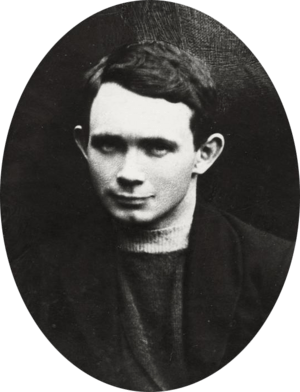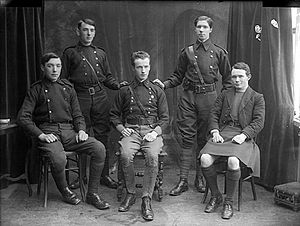Con Colbert facts for kids
Quick facts for kids
Con Colbert
|
|
|---|---|
 |
|
| Born | 19 October 1888 Castlemahon, Newcastle West, County Limerick, Ireland |
| Died | 8 May 1916 (aged 27) Kilmainham Gaol, Dublin, Ireland |
| Allegiance |
|
| Years of service | 1913–1916 |
| Rank | Captain |
| Commands held | F Company fourth Battalion |
| Battles/wars | Easter Rising |
| Relations |
|
Con Colbert (born Cornelius Bernard Colbert) was an Irish rebel and an important early member of Fianna Éireann. This was a youth movement that helped train young people in military skills. He was born on October 19, 1888, and sadly, he was executed by firing squad on May 8, 1916. This happened in Kilmainham Gaol in Dublin because of his part in the Easter Rising of 1916.
Contents
Con Colbert's Early Life
Con Colbert was born in a place called Moanleana, near Castlemahon in County Limerick. He was one of thirteen children in his family. When he was three years old, his family moved to a village called Athea. He went to the local school there.
At 16, Con left Athea and moved to Ranelagh, Dublin, to live with his sister Catherine. He continued his studies at a Christian Brothers school. He worked as a clerk at Kennedy's Bakery in Dublin. Con was a very religious Catholic and did not smoke or drink.
Joining Fianna Éireann and the Volunteers

In 1908, Con Colbert joined a secret group called the Irish Republican Brotherhood (IRB). A year later, in 1909, he joined Fianna Éireann right when it was starting. He quickly became its Chief Scout, which was a very important role. He also became a drill instructor at St. Enda's School, which was founded by Patrick Pearse.
In 1913, Con and other Fianna members gave military training. Later that year, he joined the Provisional Committee of the new Irish Volunteers. This group was formed to help Ireland gain independence.
The Easter Rising of 1916
In the weeks before the Easter Rising, Con Colbert was a bodyguard for Thomas Clarke, who was one of the leaders.
During the Easter Rising, which was a rebellion in Dublin in April 1916, Con fought bravely. He was involved in battles at places like Watkin's Brewery, Jameson's Distillery, and Marrowbone Lane. The fighting lasted for several days.
On Sunday, April 30, 1916, the Irish rebels were ordered to surrender. Con Colbert was part of the Marrowbone Lane Garrison. When the order to surrender came, he took command of his unit. He did this to protect his commanding officer, who was a married man.
After surrendering, Con and the other rebels were marched to Richmond Barracks. He was later taken to Kilmainham Gaol. On May 7, he was told he would be executed the next morning. While in prison, he wrote many letters to his family and friends. He chose not to have any visitors, saying it would be too sad for both him and his family.
Con Colbert's Execution
The night before he was executed, Con Colbert spoke with another prisoner, Mrs. Ó Murchadha. He told her he was "proud to die for such a cause." He said he would be "passing away at the dawning of the day." He gave her his Bible to give to his sister and three buttons from his uniform. He asked her to say a prayer for him and the other leaders, Éamonn Ceannt and Michael Mallin, when she heard the shots in the morning. The soldier guarding him was very moved and reportedly said, "If only we could die such deaths."
Con Colbert was executed by firing squad on the morning of May 8, 1916. He was one of the many leaders of the Easter Rising who lost their lives.
Con Colbert's Legacy
Con Colbert is remembered as a hero in Ireland. Many places are named in his honor:
- Colbert Railway Station in Limerick city.
- Con Colbert Road in Dublin.
- A political group at the University of Limerick is named after him.
- Colbert Street and the local community hall in his hometown of Athea, County Limerick.
- Colbert Avenue and Colbert Park in Janesboro, Limerick City.
In 2016, one hundred years after his execution, a large limestone sculpture of Con Colbert was unveiled at his childhood home in Moanlena, County Limerick.

